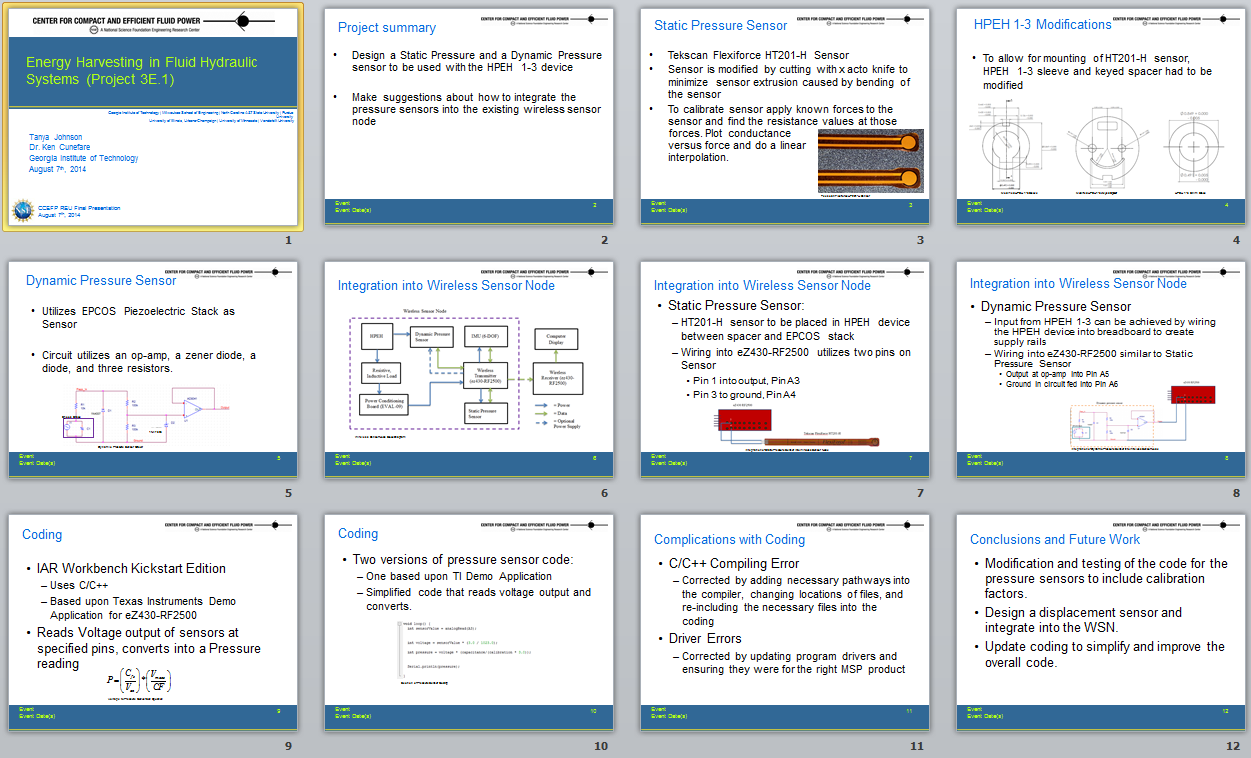I can't believe that it's the end of the program already. Summer went by quickly, which is a shame. Anyway, I hope all y'all had a great experience with your programs (and by reading your blogs, it looks like you did) and that everyone has safe travels back home. And, of course, that everyone keeps in touch.
Now, onto my final report on my project. Unfortunately I cannot disclose some of what I've done outside of the work I did on the dynamic and static pressure sensors due to the fact that it is propriety with a company and I've signed an NDA. So, I'll just stick to the proof-of concept sensors I was working on and how that turned out, though I did do work on other things over the course of the summer. A large portion of my research was done on the HPEH devices themselves, which I cannot discuss, and the other portion was working on the design of a dynamic and static pressure sensor circuits which would then be integrated into a wireless sensor network (WSN). So I'll be sticking to the WSN and the pressure sensors, which went fairly well and the presentation I did today on them went well.
Over the course of the summer, I had to put my knowledge of EE (which isn't nonexistent, I've taken a good number of EE classes with two pertaining to electronics) in order to design a dynamic pressure sensing circuit that utilizes a component of the HPEH devices to provide the pressure sensing and a second sensor, a static pressure sensor. The static sensor utilizes and off-shelf sensor base that is integrated into an overall circuit that was suggested by the manufacturer. Both of the circuits can be optimized, and should be optimized, in the future to provide a better output voltage. The static pressure sensor utilizes a resistance based sensor that will be wired into the requisite circuit then connected into the WSN. The dynamic pressure sensor utilizes a zener diode, a diode, three resistances, and an op-amp all of which can be seen in the circuit diagram below. Essentially all of the components other than the op-amp are included in the circuit to ensure that the op-amp will not overload, as (in my experience destroying op-amps and diodes in electronics labs, diodes smell awful never burn out a diode) it is not advised or an enjoyable experience to be had. Future students involved with this WSN project will be optimizing the circuits, especially the resistor values, to better improve the circuit.
Along with the design of the sensors, they had to be integrated into the WSN and then coded. The integration involved a slight redesign of the a HPEH device to accommodate the Flexiforce sensor, but I cannot discuss the intricacies of the redesign. Along with discussing a way to allow the HPEH to power both a power optimization circuit and the dynamic sensor, which can be done by use of voltage rails. One of the components of the WSN will also be used to create voltage rails to power the Flexiforce sensor, an IMU and thermistor that were previously designed, and the op-amp used in the dynamic sensor (if needed, as it may not need those voltages to turn the op-amp on, that is just a just-in-case scenario). All of the sensors will be wired into the WSN and then coding was done in order to properly read and convert voltages into pressures.
The coding was a pain and the program consistently had the same errors despite my fixing them (repeatedly) and some runs they would work, others they wouldn't. So that was extremely frustrating, but all in all the coding went okay, the code should work as expected due to how it is just reading an output at a pin and converting. I didn't get around to calibrating the pins, so there are some variables left in the coding but I have left in depth notes about what each variable means and how to modify the code, though it is a rather straight-forward code.
A snapshot of my powerpoint presentation can be seen below. I didn't make a poster, but I did a presentation and am presently working on completing a few reports (a final report and then a progress report on one of the HPEH devices), along with creating a three paragraph capstone summary to try and get a group of EEs to work on the WSN and the coding.
Future plans for the proof-of concept WSN is to design a displacement sensor and to improve upon the coding, hopefully making it more accurate and to actually get IAR to work properly. Which is why Dr. C wants to try and get some EEs or CEs involved as they should have a stronger coding background in C or C++. Ultimately the WSN and all of the sensors will be integrated and tested on GT's test rig and possibly with one of the test rigs at Purdue, which would be really cool.
What I'm taking away from this experience was that I do want to go to Grad School (good thing I figured that out now, since I need to apply within the next few months) and that I'm fairly certain I want to go into an acoustics and thermofluids related field, possibly with regards to energy maybe not but I definitely do what to consider pursuing this kind of acoustics work. Along with how to put together an indepth report, presentation, and (as I was assigned this today) a possible Capstone summary which I need to figure out how to write. Along with how to communicate through emails and to improve my communication skills and research skills.
- Tanya


No comments:
Post a Comment